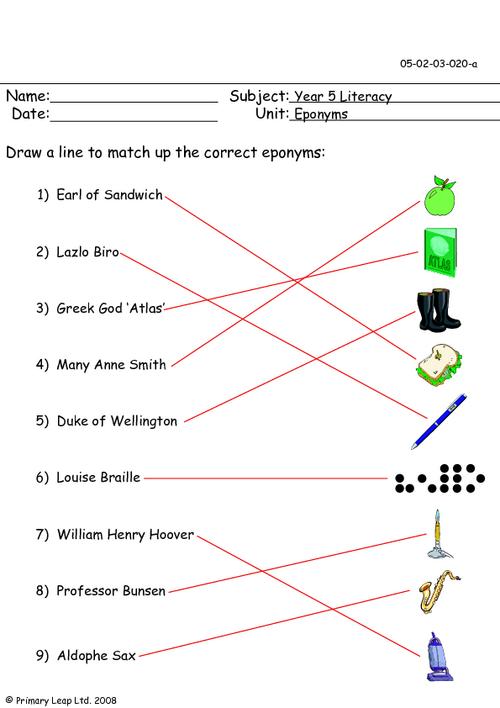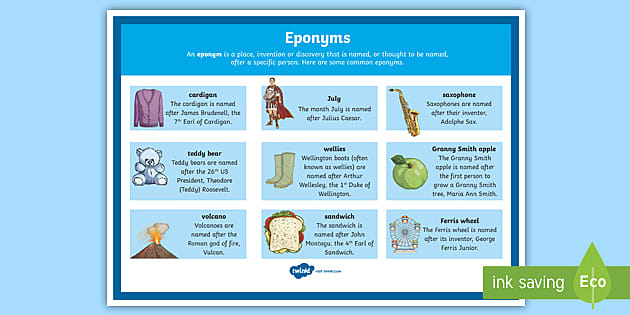
Unlocking Language and History: The Power of Eponyms Worksheets
Language is a living, breathing entity, constantly evolving, borrowing, and creating. Within its intricate tapestry, some words carry stories, histories, and even the names of the individuals or places that inspired them. These are eponyms – words derived from the name of a person, place, or thing. From the mundane to the scientific, eponyms pepper our everyday vocabulary, often without us even realizing their fascinating origins. Understanding these words not only enriches one’s vocabulary but also provides a unique window into history, culture, and human ingenuity. For educators, leveraging this rich linguistic phenomenon through targeted Eponyms worksheets offers an unparalleled opportunity to engage students, foster critical thinking, and build a profound appreciation for the English language.
The Allure of Eponyms: More Than Just Words
Eponyms are captivating because they transform abstract words into tangible connections to the past. Consider some classic examples:

- Sandwich: Named after John Montagu, the 4th Earl of Sandwich, who allegedly requested meat between two slices of bread to avoid interrupting his gambling.
- Boycott: Derived from Captain Charles Boycott, an Irish land agent whose harsh treatment of tenants led to a campaign of social and economic ostracism against him.
- Celsius: Named after Swedish astronomer Anders Celsius, who devised the centigrade temperature scale.
- Braille: Invented by Louis Braille, who developed a tactile system of reading and writing for the blind.
- Diesel: From Rudolf Diesel, the German inventor of the diesel engine.
- Guillotine: Named after Dr. Joseph-Ignace Guillotin, a French physician who advocated for a more humane method of execution.
- Chauvinism: Originating from Nicolas Chauvin, a legendary, fanatically devoted soldier in Napoleon’s army.





These are just a few drops in the vast ocean of eponyms. They span across various fields: science (Watt, Ohm, Volt, Pasteurize), fashion (Denim, Cardigan, Mackintosh), mythology (Atlas, Narcissism), and even food (Magnum, Nachos). Each eponym is a miniature history lesson, a cultural artifact, and a testament to the impact individuals and places can have on the lexicon.
Why Eponyms Worksheets Are Indispensable Educational Tools

While simply listing eponyms can be informative, true learning occurs through interaction, exploration, and application. This is where Eponyms worksheets become an invaluable resource for educators across all levels, from elementary to advanced learners. They are not merely supplementary materials but rather structured learning activities that provide a framework for students to:
- Actively Engage: Worksheets move beyond passive listening, requiring students to research, analyze, and synthesize information.
- Reinforce Concepts: Repetition and varied exercises solidify understanding and memory retention.
- Provide Practice: Consistent practice in identifying, defining, and using eponyms builds confidence and proficiency.
- Assess Understanding: Worksheets offer a tangible way for educators to gauge student comprehension and identify areas needing further attention.
- Foster Independent Learning: Many worksheets can be completed individually, promoting self-directed learning and responsibility.


The Multifaceted Benefits of Incorporating Eponyms Worksheets
The pedagogical advantages of using Eponyms worksheets extend far beyond simple vocabulary acquisition. They tap into multiple learning domains, offering a holistic educational experience:
-
Vocabulary Expansion: This is the most direct benefit. Students learn new words and, crucially, understand their etymological roots, which helps in remembering their meanings and recognizing related words. Learning "boycott" alongside its origin story makes it far more memorable than just memorizing a definition.
-
Historical and Cultural Literacy: Each eponym is a portal to a specific historical event, a significant figure, or a cultural phenomenon. Studying "chauvinism" leads to discussions about Napoleon’s era, while "sandwich" offers a peek into 18th-century British aristocracy. This interdisciplinary connection enriches students’ understanding of history, geography, and social studies.
-
Critical Thinking and Etymological Exploration: Eponyms encourage students to think critically about language. Why was this word named after that person? What does it reveal about the context of its creation? This fosters an analytical approach to language, prompting students to question, research, and connect dots, moving beyond rote memorization. They learn to trace word origins, a skill valuable for understanding complex vocabulary.
-
Interdisciplinary Connections: Eponyms naturally bridge subjects. Science classes can explore "Volt" (Alessandro Volta) or "Watt" (James Watt), connecting physics concepts to human ingenuity. History classes can delve into "Machiavellian" (Niccolò Machiavelli) or "Luddite" (Ned Ludd). Language arts classes benefit from the sheer expansion of vocabulary and the exploration of narrative origins.
-
Enhanced Engagement and Curiosity: The stories behind eponyms are inherently interesting. They are human stories of invention, discovery, folly, and heroism. Presenting these through well-designed worksheets can spark curiosity, making learning an exciting detective mission rather than a chore. Students become invested in uncovering the hidden narratives within words.
Designing Effective Eponyms Worksheets: A Practical Guide
When designing Eponyms worksheets, variety and pedagogical soundness are paramount. A single format can become monotonous, so incorporating diverse activity types keeps students engaged and caters to different learning styles. Here are several effective approaches:
-
Matching Exercises:
- Person to Word: Match the name of the person (e.g., "Louis Braille") to the eponym (e.g., "braille").
- Word to Definition: Match the eponym to its correct definition, or to a brief description of its origin.
- Origin Story to Word: Match a short historical anecdote to the eponym it describes.
-
Fill-in-the-Blanks & Sentence Construction:
- Provide sentences with a blank space where an eponym should be inserted, based on context clues.
- Ask students to use given eponyms correctly in original sentences, demonstrating understanding of both meaning and usage.
-
Research & Discovery Tasks:
- Assign a list of lesser-known eponyms for students to research, find their origins, and write a short paragraph explaining each.
- Challenge students to find an eponym related to a specific field (e.g., medicine, sports, literature) and present their findings.
-
Creative Writing Prompts:
- Ask students to write a short story or a fictional dialogue incorporating a set number of eponyms.
- Encourage them to imagine a new invention or concept and propose an eponym for it, explaining their reasoning.
-
Contextual Usage & Debate:
- Present scenarios or ethical dilemmas where certain eponyms (like "Machiavellian" or "Luddite") might apply, prompting discussion and debate.
- Have students analyze news articles or literary texts to identify and interpret eponyms used in context.
-
Crosswords & Word Searches:
- Create crosswords where clues are definitions or origin stories of eponyms.
- Word searches can be a fun way to familiarize students with the spelling of eponyms.
Incorporating visuals like historical portraits, maps, or relevant diagrams can also significantly enhance the appeal and clarity of these worksheets. Providing answer keys is crucial for self-assessment and teacher efficiency.
Integrating Eponyms Worksheets into the Curriculum
Integrating Eponyms worksheets seamlessly into the existing curriculum enhances learning without feeling like an added burden. They can serve as:
- Warm-up Activities: Start a lesson with an eponym related to the day’s topic.
- Vocabulary Builders: Dedicate a segment of language arts to eponyms, perhaps one per week.
- Historical Context Enhancers: When studying a specific period, introduce eponyms that emerged from or are relevant to that time.
- Science Class Connections: Explore eponyms related to scientific units, laws, or discoveries as part of a unit.
- Project-Based Learning: Assign students to create their own "Eponym Dictionary" or a presentation on their favorite eponyms.
Best Practices for Maximizing the Impact of Eponyms Worksheets
To ensure that Eponyms worksheets yield the best results, educators should consider these best practices:
- Scaffolding: Start with simpler, more common eponyms and gradually introduce more complex ones. Provide context and hints when necessary.
- Visual Aids: Supplement worksheets with images, videos, or even short audio clips related to the eponym’s origin.
- Discussion and Collaboration: Encourage students to discuss their findings, share their favorite eponyms, and collaborate on research tasks.
- Personal Connection: Help students identify eponyms in their own lives or interests (e.g., brand names, common phrases).
- Regular Review: Periodically revisit previously learned eponyms to reinforce memory and ensure long-term retention.
The Future of Language Learning with Eponyms Worksheets
In an increasingly digital age, the potential of Eponyms worksheets in a digitally evolving educational landscape is immense. Interactive online worksheets, gamified eponym challenges, and multimedia resources can further enhance their effectiveness. However, the core value remains: they provide a structured, engaging, and historically rich pathway to vocabulary acquisition and cultural understanding.
Ultimately, by embracing the power of Eponyms worksheets, educators equip students not just with a larger vocabulary, but with a deeper appreciation for the nuanced beauty of language, its intricate connection to human history, and the endless stories hidden within the words we speak every day. They transform the abstract concept of language into a tangible, exciting journey of discovery, ensuring that Eponyms worksheets remain a cornerstone of rich, contextualized vocabulary acquisition.
